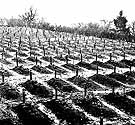
|
|
|

|

|

|

|
|
Click on an image to see a larger, more detailed picture.
|
|
|
|
|
| 1943: Death and Resistance |

|
pg. 497 |

|
|
|
|
| |
 Pictured is the cemetery at Hadamar, Germany, where one of the largest extermination centers of the "euthanasia" program was located. The bodies of the victims--who had received lethal injections, were gassed, or were simply allowed to die from starvation--were usually cremated. Next of kin were informed that they had died of a contagious disease. During 1942 and 1943, many of the leading figures from the euthanasia program brought their "talents" to the death camps of Eastern Europe.
Pictured is the cemetery at Hadamar, Germany, where one of the largest extermination centers of the "euthanasia" program was located. The bodies of the victims--who had received lethal injections, were gassed, or were simply allowed to die from starvation--were usually cremated. Next of kin were informed that they had died of a contagious disease. During 1942 and 1943, many of the leading figures from the euthanasia program brought their "talents" to the death camps of Eastern Europe.
Photo: SYddeutscher Verlag Bilderdienst
|
 General Field Marshal Wilhelm Keitel was the chief of staff of the German High Command. As Hitler's closest military adviser, Keitel never questioned Hitler's plans and remained silent when he disagreed with the Führer. Many of the notorious orders issued for genocidal operations in Eastern Europe bear Keitel's signature. Keitel was convicted by the International Military Tribunal at Nuremberg, Germany, of conspiracy, crimes against peace, and crimes against humanity. After his request to be shot as a soldier was denied, General Keitel was hanged on October 16, 1946.
General Field Marshal Wilhelm Keitel was the chief of staff of the German High Command. As Hitler's closest military adviser, Keitel never questioned Hitler's plans and remained silent when he disagreed with the Führer. Many of the notorious orders issued for genocidal operations in Eastern Europe bear Keitel's signature. Keitel was convicted by the International Military Tribunal at Nuremberg, Germany, of conspiracy, crimes against peace, and crimes against humanity. After his request to be shot as a soldier was denied, General Keitel was hanged on October 16, 1946.
Photo: Richard A. Ruppert / United States Holocaust Memorial Museum Photo Archive
|
 German Resistance
German Resistance
Many different faces composed the German resistance. Military men and pastors, diplomats and jurists, and political leaders of vastly different persuasions united in the conviction that Nazi rule must end. Not all agreed on the means to that goal. In Munich, the White Rose organization of students Hans and Sophie Scholl printed leaflets opposing Hitler. This action led to their capture and execution. The Kreisau Circle of Helmuth James Graf von Moltke (pictured) planned for a new Germany guided by Christian principles. Their planning for a future free of Nazism resulted in their deaths. The military group led by charismatic Colonel Claus von Stauffenberg plotted to assassinate Hitler with a bomb and establish a government that would make peace with the Allies. Their plot nearly succeeded, but Hitler survived. The conspirators and any associated with them, including Lutheran pastor Dietrich von Bonhoeffer, were killed. Some were shot; others were tortured and then sent to the Plötzensee Prison, where they were hung from meat hooks until they slowly strangled to death. From all strata of society, Germans of conscience and conviction opposed Nazi tyranny and obstructed the growing persecution of the Jews. For many, challenging authority cost them their lives.
Photo: Bilderdienst SYddeutscher Verlag
|
|

|

|

|

|
 November 9, 1943: Two hundred Jews from Venice, Italy, are deported to Auschwitz. Four hundred Jews from Florence and Bologna, Italy, are deported to Auschwitz.
November 9, 1943: Two hundred Jews from Venice, Italy, are deported to Auschwitz. Four hundred Jews from Florence and Bologna, Italy, are deported to Auschwitz.
|
 November 9, 1943: At the Theresienstadt, Czechoslovakia, camp/ghetto, Council of Elders head Jacob Edelstein and three other Jews are accused of saving 55 of the ghetto's Jews from deportation by falsifying population reports.
November 9, 1943: At the Theresienstadt, Czechoslovakia, camp/ghetto, Council of Elders head Jacob Edelstein and three other Jews are accused of saving 55 of the ghetto's Jews from deportation by falsifying population reports.
|
 November 9, 1943: U.S. Senator Guy Gillette and Representatives Will Rogers and Joseph Baldwin introduce a resolution into Congress calling upon the president to establish "a commission of diplomatic, economic, and military experts to formulate and effectuate a plan of action to save the surviving Jewish people of Europe." This resolution will serve as the basis of the War Refugee Board (WRB).
November 9, 1943: U.S. Senator Guy Gillette and Representatives Will Rogers and Joseph Baldwin introduce a resolution into Congress calling upon the president to establish "a commission of diplomatic, economic, and military experts to formulate and effectuate a plan of action to save the surviving Jewish people of Europe." This resolution will serve as the basis of the War Refugee Board (WRB).
|
 November 9, 1943: The United Nations Relief and Rehabilitation Administration (UNRRA) is founded.
November 9, 1943: The United Nations Relief and Rehabilitation Administration (UNRRA) is founded.
|
 November 10, 1943: Anti-Nazi, German Protestant theologian Karl Friedrich Stellbrink is executed at Hamburg, Germany.
November 10, 1943: Anti-Nazi, German Protestant theologian Karl Friedrich Stellbrink is executed at Hamburg, Germany.
|
|
|
|
|
| 1943: Death and Resistance |

|
pg. 497 |

|
|
The Holocaust Chronicle
© 2009 Publications International, Ltd.
|
|
